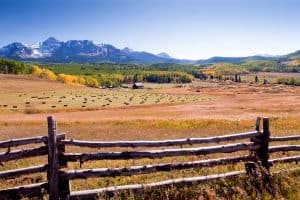Four types of easements are not agreed to: easement by necessity, easement by implication, easement by prescription and easement by condemnation.
1. An easement by necessity prevents certain properties from being landlocked, that is, cut off from a public road. If I were to sell 50 acres at the back of my 100-acre tract and provided no access easement to the buyer, he could get a court to grant him an access easement for a road over me by necessity so that he could reach his 50 acres. The buyer in this example should be aware that the court may not award him the location for a right of way that he wants. Easement by necessity may also be used to gain access to a water source in certain circumstances.
To gain an easement by necessity, the landlocked party must prove that his parcel was once part of the parcel that he wants to cross. In Virginia, at least, property can be landlocked if this cannot be proved in court.
2. An easement by implication is the idea that the owner of a property has a right to a use on the property of another that was “reasonably necessary” for the use of the property when it was conveyed. To establish this type of easement over another’s property, the use should have been continuous and obvious. This can be a slippery idea, and whether or not a court agrees depends on the facts in each case. An easement by implication might be granted to an owner who has used a river ford on another’s land for many years as have his predecessors in title.
3. An easement by prescription, or prescriptive use, is a hostile take-over of a use. It is an implied easement that is established when the party seeking an easement over the property of another proves that he and/or previous owners of his property have used the other’s property continuously for the minimum number of years specified under state law, openly and without the owner’s permission. This claim to use the property of another must be adverse, that is, with his knowledge and acquiescence of a use that runs against his own rights in his property.
The party claiming a prescriptive use need not have paid property taxes on the land on which the use is asserted. Some states may require that a prescriptive use be exclusive, that is, limited to one party; others permit more than one party to claim and benefit from a hostile easement.
If the party claiming prescriptive use was given permission to use the property, prescriptive easement will not be awarded. And a prescriptive easement will not be awarded if the servient tenement — which would bear the easement — has a mortgage.
The party claiming prescriptive use must meet every standard that state law has established. Prescriptive use amounts to a private taking of a right in another’s property, but not a taking of ownership.
Access roads are often the subject of prescriptive-easement disputes. Another example occurs when one landowner fences in land that he doesn’t own. This is called an encroachment. In certain circumstances, the encroachment may be awarded as a prescriptive easement to the party who did the encroaching.
In California, a landowner who has enjoyed a scenic view over another’s property can establish his right to that view by prescription. In most states, scenic views cannot be established by prescription.
If you, a buyer, are told by a seller or his real-estate agent that he has a prescriptive easement to access his property, be aware that the seller may have no legal access at all.
A prescriptive easement comes into existence only upon a court’s ruling. The opinion of the seller and his agent amount to an opinion, nothing more.
4. Public authority (or a private organization with a statutory right) can acquire the use of private land against the owner’s wishes through an easement by condemnation. A township can build a new road over private land by acquiring an easement through eminent domain. Electric utilities can do the same. Owners are supposed to be given fair compensation for their loss.
A conservation easement (CEs) is either donated or sold to a public agency or land-trust organization. Its purpose is to protect or conserve some statutorily recognized environmental value, such as habitat for endangered species, open space, wetlands or aesthetics. Most CEs are being used to limit or prohibit development on undeveloped land and farms.
A CE donor gets a wonderful package of local, state, federal and estate tax benefits for conveying a limitation on some right in his property in perpetuity. A CE’s financial value is determined by appraisal.
A property burdened by a CE is worth less — sometimes far less — than it’s worth free of the restriction. A CE, for example, might prohibit residential development on a 200-acre farm surrounded by suburban housing or prohibit timber cutting on land with valuable timber.
A seller should give a buyer notice that the seller’s property carries an easement restricting its use. Recordation amounts to notice. With an unrecorded easement, a buyer who has no notice and could not have observed the use may be able to free the property of its easement, depending on what kind it is.
Easements can be ended. The holder of an easement can record a release, which gives up his right voluntarily. The dominant and servient tenements can negotiate a termination. An easement can end when the purpose for which it was established ends or the term of the easement expires.
An easement can also be abandoned by its holder or terminated by merger when the dominant tenement buys the servient tenement, or vice versa.
If the dominant tenement changes its usage of an easement beyond what was provided, the servient tenement may be able to have the easement voided altogether. If, for instance, A has an access easement to use a road over B and A decides to rezone his property from agriculture to commercial to allow for a 24-hour ATV racecourse, B should be able to terminate the access easement for A’s new use.
Other kinds of easements that show up in the country include:
- recreational easements, whereby a state gives property-tax breaks to owners who agree to allow use of their property by the public for activities such as hiking, horseback riding, hunting, fishing and biking.
- solar easements, which prevent one landowner from blocking sunlight coming on to an adjacent landowner.
- utility easements for electric-power and telephone lines, and fuel pipelines. These also involve the holder’s right to maintain their lines.
- access to beaches or surface waters
- historic-preservation easement, which grants the right of preserving the interior and/or exterior of a historic building, usually in return for tax deductions. This easement prevents the owner of the property from changing the building’s appearance.
It’s the buyer’s obligation to understand the nature of any easement that exists in relation to land being purchased. The seller may be the single source of information on non-recorded easements. A title search will turn up all recorded easements, but not unrecorded ones.
It’s worth talking to a local real-estate lawyer about these matters before submitting a purchase offer.
Easements are a complicated and thorny area of the law. The facts of a specific case generally drive a court’s decision. If you find yourself with an ambiguous or contentious easement, hire the best local real-estate lawyer you can afford.
This content may not be used or reproduced in any manner whatsoever, in part or in whole, without written permission of LANDTHINK. Use of this content without permission is a violation of federal copyright law. The articles, posts, comments, opinions and information provided by LANDTHINK are for informational and research purposes only and DOES NOT substitute or coincide with the advice of an attorney, accountant, real estate broker or any other licensed real estate professional. LANDTHINK strongly advises visitors and readers to seek their own professional guidance and advice related to buying, investing in or selling real estate.









We own a piece of property that was landlocked so an easement was created. 20 feet is on our property with 10 feet on the neighbor to our north. We went to court-all records show it is our easement and not his. The juge ruled in our favor but gave the neighbor 30 days to come up with something else-he couldn’t come up with anything in 16 months, but now all of the sudden he claims he has an implied easement, so the judge reversed his decision? Our neighbors to the east also have the easement. In their 2 1/2 years and our 1 1/2 years of living here we, together have only see him use it a handful of times. He has his own driveway. He said his previous owners told him he could use it. If he gets an implied easement does he have the right to tell us what we can and cannot do with our portion of the easement on our property, and does he have to help maintain it? In the court records all it shows is that my husband & I and our neighbors to the east who also have the easement are the ones who are responsible to maintain the easement. We are so confused-we thought that court records were law and hearsay on wether or not you have the right to use it is only that-hearsay. Help!!!!
Great article- whatever type of easement there may be, I guarantee that whoever’s ranch you are cutting through to get to yours is not appreciated. At best it’s permissive, at worst you end up getting shot at (which has actually happened to me on our ranch years ago). Ha ha- thought that may be worth sharing! If at all possible, get public road frontage-
Help! to my understanding, an easement is the shortest and straight route to a public road. my neighbor bought some landlocked property w/o an easement in the deed and he wants to use our property which is not in line with the public road. He has threatened court, What rights do I have?